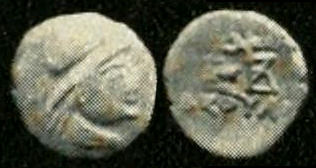Top Qs
Timeline
Chat
Perspective
Liaka Kusulaka
Indo-Scythian satrap of the area of Chukhsa, west of Taxila, in the 1st-century BCE From Wikipedia, the free encyclopedia
Remove ads
Liaka Kusulaka (Greek: Λιακο Κοζουλο Liako Kozoulo, on his coins; Prakrit: Liaka Kusulaka or 𐨫𐨁𐨀𐨐𐨆 𐨐𐨂𐨯𐨂𐨫𐨂𐨐𐨆 Li-a-ko Ku-su-lu-ko, Liako Kusuluko, on the Taxila copper plate[1]) was an Indo-Scythian satrap of the area of Chukhsa in northwestern India during the 1st century BCE.

Name
Liaka Kusulaka name is recorded on his coins in the Greek form Liako Kozoulo (Λιακο Κοζουλο), and on the Taxila copper plate in the Kharosthi form Liako Kusuluko (𐨫𐨁𐨀𐨐𐨆 𐨐𐨂𐨯𐨂𐨫𐨂𐨐𐨆).[1] The name is composed od from Saka *Ryaka, meaning "youth" and *Kuzulaka "striving, ambitious, energetic".[2]
Reign

He is mentioned in the Taxila copper plate inscription (Konow 1929: 23-29), dated between 90 and 6 BCE, as the father of Patika Kusulaka, and is characterized as a "kshaharata" (also the name of the first dynasty of the Western Satraps) and as kshatrapa of Chukhsa.
He minted coins which are direct imitations of the coins of Eucratides (King's head and Dioscuri), with his name inscribed "ΛΙΑΚΟ ΚΟΖΟΥΛΟ".
The name "Κοζουλο" was also used by the first Kushan ruler Kujula Kadphises (Greek: Κοζουλου Καδφιζου, Kozoulou Kadphizou or Κοζολα Καδαφες, Kozola Kadaphes), which may suggest some family connection.[3]
Remove ads
Notes
External links
Wikiwand - on
Seamless Wikipedia browsing. On steroids.
Remove ads
